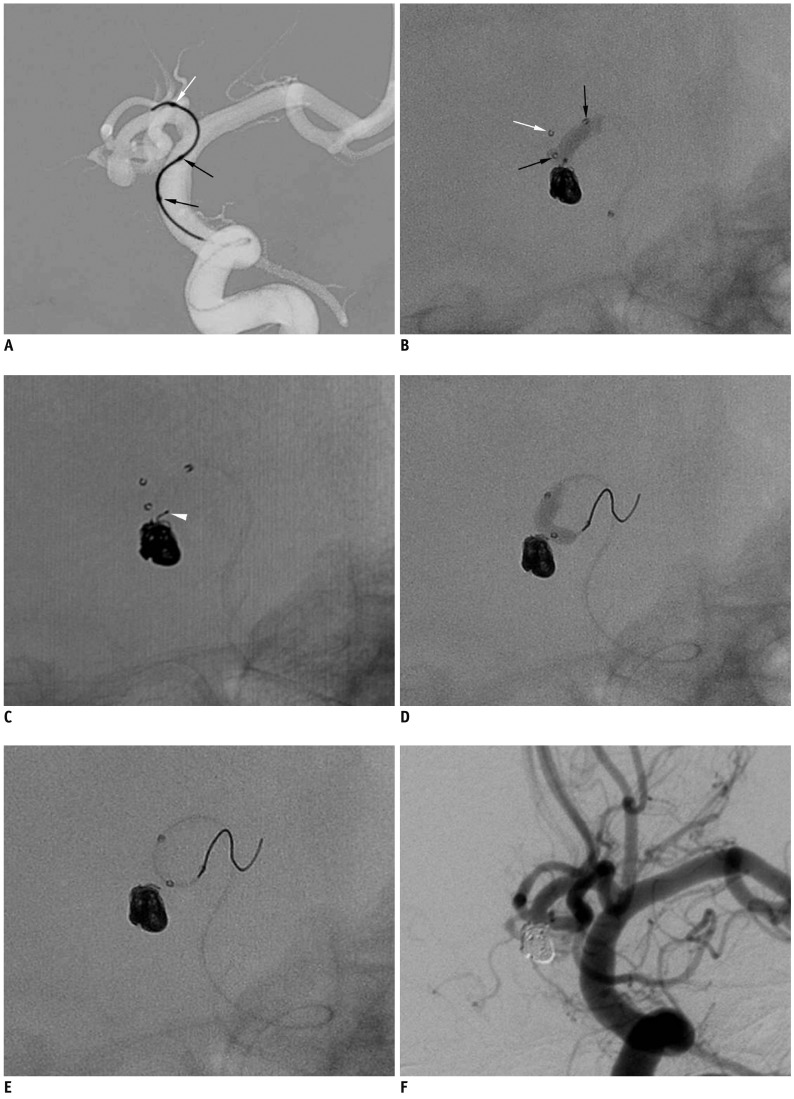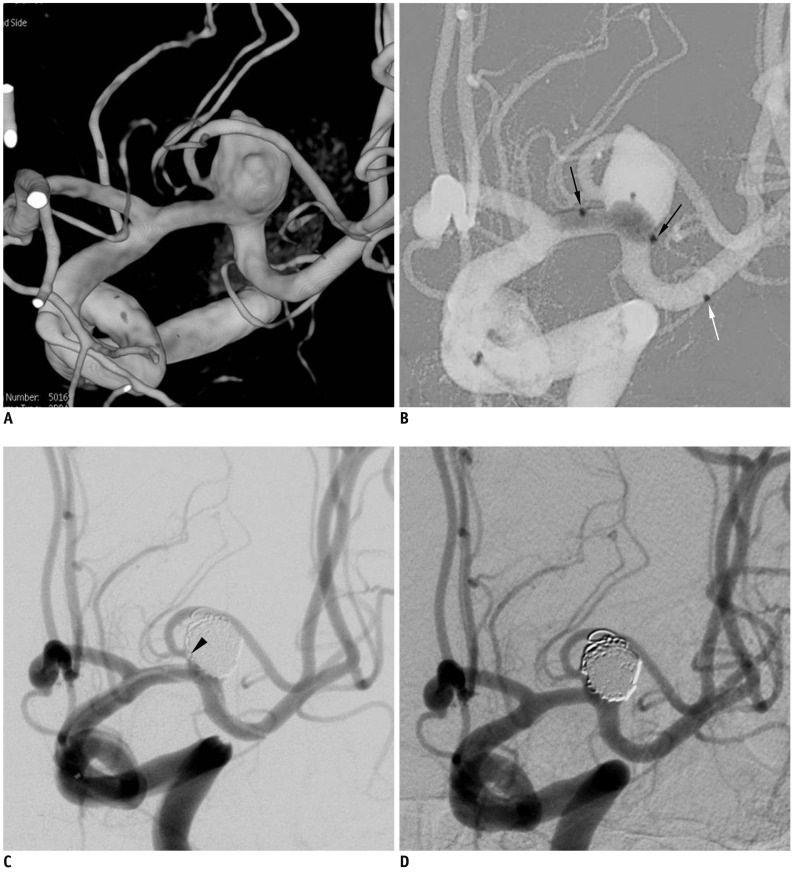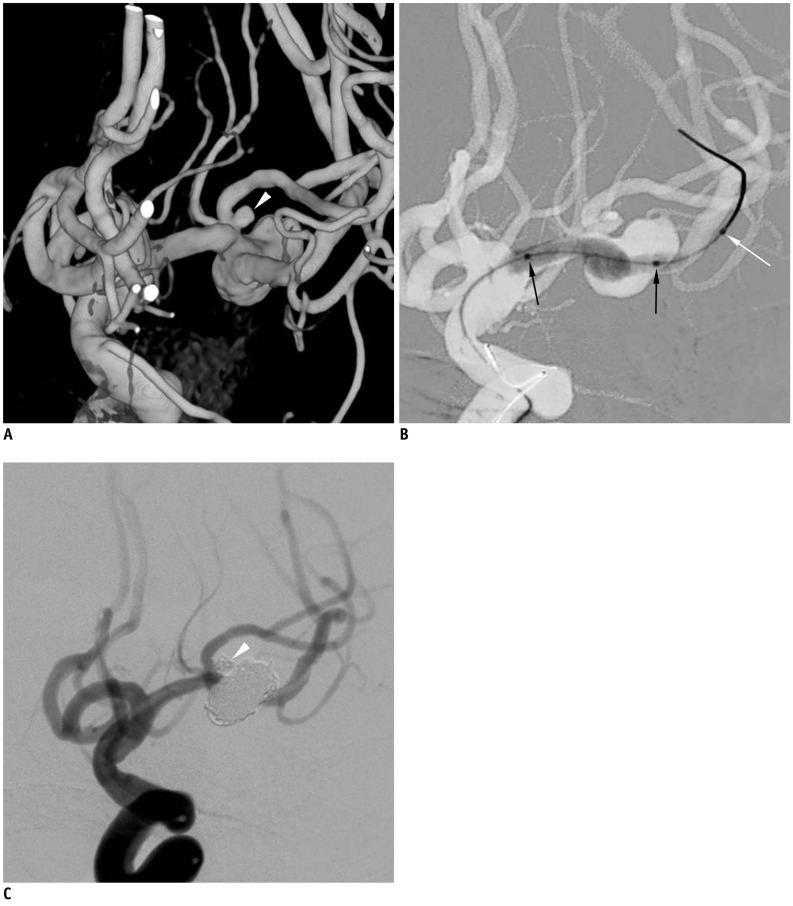Korean J Radiol.
2013 Oct;14(5):832-840. 10.3348/kjr.2013.14.5.832.
Initial Experience with the New Double-lumen Scepter Balloon Catheter for Treatment of Wide-necked Aneurysms
- Affiliations
-
- 1Department of Radiology, Kangbuk Samsung Hospital, Sungkyunkwan University School of Medicine, Seoul 110-746, Korea.
- 2Department of Radiology, Yonsei University College of Medicine, Severance Hospital, Seoul 120-752, Korea. bmoon21@hanmail.net
- 3Department of Radiology, Yonsei University College of Medicine, Gangnam Severance Hospital, Seoul 135-720, Korea.
- KMID: 1711443
- DOI: http://doi.org/10.3348/kjr.2013.14.5.832
Abstract
OBJECTIVE
A new double-lumen balloon catheter was being developed for the treatment of cerebral aneurysms. The purpose of this study is to report our initial experience of a double-lumen balloon catheter for the treatment of wide-necked aneurysms.
MATERIALS AND METHODS
Seventeen patients (mean age, 63 years; range, 45-80 years) with wide-necked, with or without a branch-incorporated aneurysms, (10 ruptured and 9 unruptured) were treated with balloon-assisted coil embolization using a double-lumen balloon catheter (Scepter C(TM) or Scepter XC(TM)) for 7 months after being introduced to our country. Locations of the aneurysms were posterior communicating artery (n = 7), anterior communicating artery or A2 (n = 7), middle cerebral artery (MCA) bifurcation (n = 3), basilar artery tip (n = 1) and anterior choroidal artery (n = 1). The initial clinical and angiographic outcomes were retrospectively evaluated.
RESULTS
Coil embolization was successfully completed in all 19 aneurysms, resulting in complete occlusions (n = 18) or residual neck (n = 1). In one procedure, a thrombus formation was detected at the neck portion of the ruptured MCA bifurcation aneurysm near to the end of the procedure. It was completely resolved with an intra-arterial infusion of Glycoprotein IIb/IIIa inhibitor (Tirofiban, 1.0 mg) without any clinical sequela. There were no treatment-related events in the remaining 18 aneurysms. At discharge, functional neurological state improved in 11 patients (10 patients with ruptured aneurysm and 1 with unruptured aneurysm presenting with mass symptoms) and 6 patients with unruptured aneurysms had no newly developed symptoms.
CONCLUSION
In this preliminary case series, the newly developed double-lumen Scepter balloon appears to be a safe and convenient device for coil embolization of wide-necked aneurysms.
Keyword
MeSH Terms
Figure
Cited by 2 articles
-
A Newly-Developed Flow Diverter (FloWise) for Internal Carotid Artery Aneurysm: Results of a Pilot Clinical Study
Byung Moon Kim, Keun Young Park, Jae Whan Lee, Joonho Chung, Dong Joon Kim, Dong Ik Kim
Korean J Radiol. 2019;20(3):505-512. doi: 10.3348/kjr.2018.0421.Comparison Between Balloon-Assisted and Stent-Assisted Technique for Treatment of Unruptured Internal Carotid Artery Aneurysms
Keun Young Park, Byung Moon Kim, Dong Joon Kim
Neurointervention. 2016;11(2):99-104. doi: 10.5469/neuroint.2016.11.2.99.
Reference
-
1. Kim BM, Park SI, Kim DJ, Kim DI, Suh SH, Kwon TH, et al. Endovascular coil embolization of aneurysms with a branch incorporated into the sac. AJNR Am J Neuroradiol. 2010; 31:145–151. PMID: 19749218.
Article2. Raymond J, Guilbert F, Weill A, Georganos SA, Juravsky L, Lambert A, et al. Long-term angiographic recurrences after selective endovascular treatment of aneurysms with detachable coils. Stroke. 2003; 34:1398–1403. PMID: 12775880.
Article3. Jeon P, Kim BM, Kim DI, Park SI, Kim KH, Kim DJ, et al. Reconstructive endovascular treatment of fusiform or ultrawide-neck circumferential aneurysms with multiple overlapping enterprise stents and coiling. AJNR Am J Neuroradiol. 2012; 33:965–971. PMID: 22268079.
Article4. Kim BM, Kim DJ, Kim DI. Stent application for the treatment of cerebral aneurysms. Neurointervention. 2011; 6:53–70. PMID: 22125751.
Article5. Roh HG, Chun YI, Choi JW, Cho J, Moon WJ, Solander S. Retrograde stent placement for coil embolization of a wide-necked posterior inferior cerebellar artery aneurysm. Korean J Radiol. 2012; 13:510–514. PMID: 22778576.
Article6. Kim DJ, Suh SH, Kim BM, Kim DI, Huh SK, Lee JW. Hemorrhagic complications related to the stent-remodeled coil embolization of intracranial aneurysms. Neurosurgery. 2010; 67:73–78. discussion 78-79. PMID: 20559093.
Article7. Piotin M, Blanc R, Spelle L, Mounayer C, Piantino R, Schmidt PJ, et al. Stent-assisted coiling of intracranial aneurysms: clinical and angiographic results in 216 consecutive aneurysms. Stroke. 2010; 41:110–115. PMID: 19959540.8. Shapiro M, Becske T, Sahlein D, Babb J, Nelson PK. Stent-supported aneurysm coiling: a literature survey of treatment and follow-up. AJNR Am J Neuroradiol. 2012; 33:159–163. PMID: 22033717.
Article9. Sluzewski M, van Rooij WJ, Beute GN, Nijssen PC. Balloon-assisted coil embolization of intracranial aneurysms: incidence, complications, and angiography results. J Neurosurg. 2006; 105:396–399. PMID: 16961133.
Article10. Pierot L, Cognard C, Anxionnat R, Ricolfi F. CLARITY Investigators. Remodeling technique for endovascular treatment of ruptured intracranial aneurysms had a higher rate of adequate postoperative occlusion than did conventional coil embolization with comparable safety. Radiology. 2011; 258:546–553. PMID: 21131582.
Article11. Pierot L, Cognard C, Spelle L, Moret J. Safety and efficacy of balloon remodeling technique during endovascular treatment of intracranial aneurysms: critical review of the literature. AJNR Am J Neuroradiol. 2012; 33:12–15. PMID: 21349960.
Article12. Gory B, Kessler I, Seizem Nakiri G, Riva R, Al-Khawaldeh M, Mounayer C. Initial experience of intracranial aneurysm embolization using the balloon remodeling technique with Scepter C, a new double-lumen balloon. Interv Neuroradiol. 2012; 18:284–287. PMID: 22958766.
Article13. Spiotta AM, Miranpuri A, Hawk H, Chaudry MI, Turk AS, Turner RD. Balloon remodeling for aneurysm coil embolization with the coaxial lumen Scepter C balloon catheter: initial experience at a high volume center. J Neurointerv Surg. 2012; [Epub ahead of print].
Article
- Full Text Links
- Actions
-
Cited
- CITED
-
- Close
- Share
- Similar articles
-
- Usefulness of "Double-catheter" Technique in GDC Treatment of Intracranial Wide-necked Aneurysm
- Balloon-Assisted Coil Embolization and Balloon Angioplasty for Post Subarachnoid Hemorrhage Vasospasm: Initial Experience with Scepter Mini Balloon
- Double-Balloon-Assisted Coiling for Wide-Necked Posterior Communicating Artery Aneurysms with a Fetal-Type Variant of the Posterior Cerebral Artery: A Case Series
- Initial experience with Scepter Mini dual lumen balloon for embolization of cerebrovascular diseases
- Endovascular Treatment of Wide-Necked Intracranial Aneurysms Using Balloon-Assisted Technique with HyperForm Balloon




